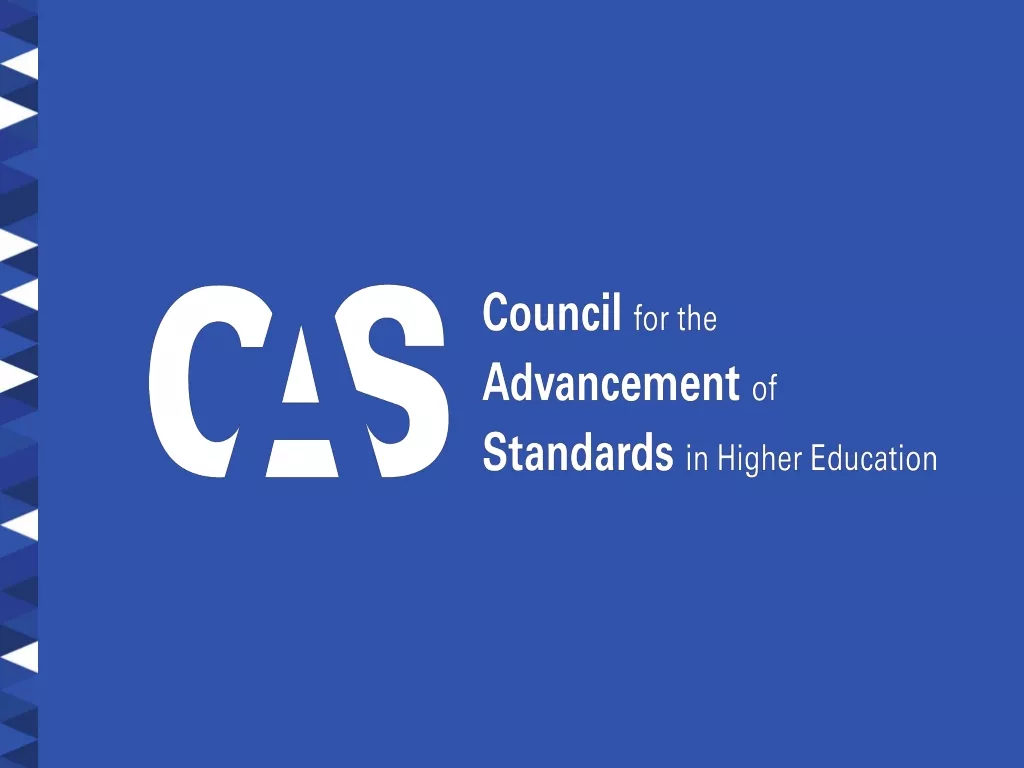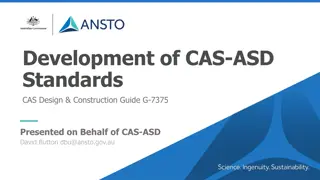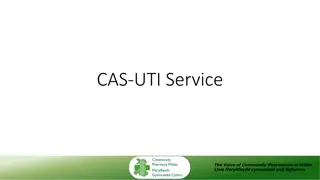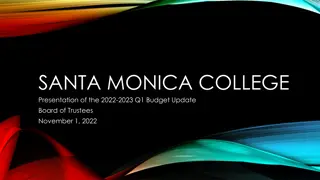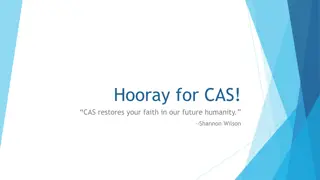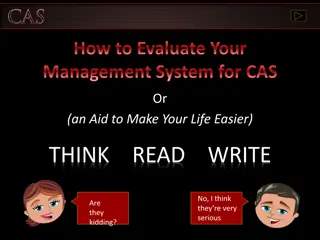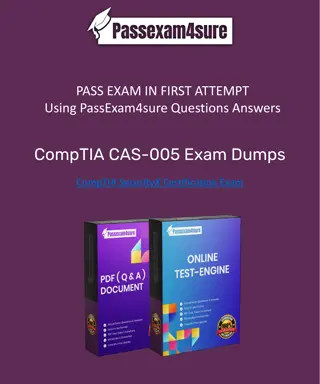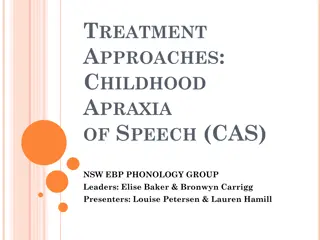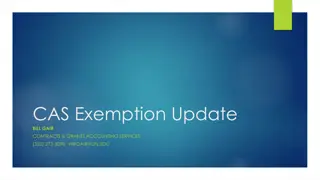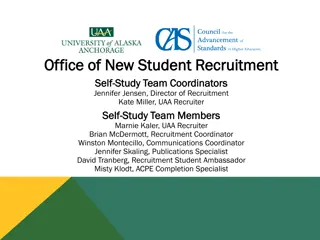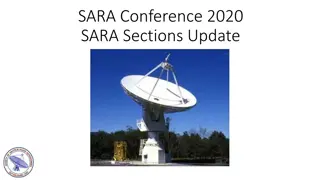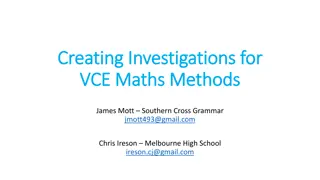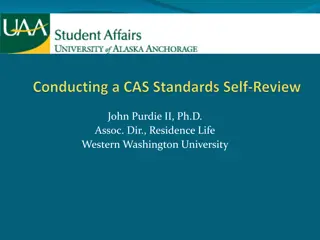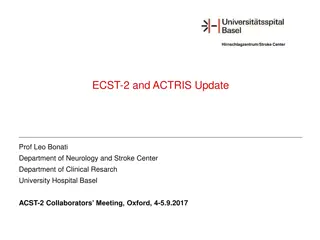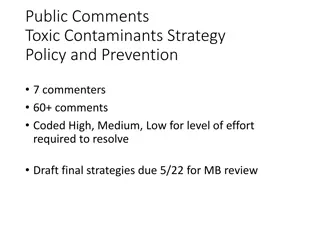
Health & Human Services Program Support Center - Cost Allocation Services Updates
"Discover the latest updates from the Department of Health & Human Services Program Support Center's Cost Allocation Services. Learn about mission statements, external customers, accomplishments, and upcoming changes in rate agreements. Stay informed about negotiations, trends, and services provided to Federal Departments and Agencies. Find out about the commitment to excellence, professionalism, and fairness in communication with grantee communities."
Download Presentation

Please find below an Image/Link to download the presentation.
The content on the website is provided AS IS for your information and personal use only. It may not be sold, licensed, or shared on other websites without obtaining consent from the author. If you encounter any issues during the download, it is possible that the publisher has removed the file from their server.
You are allowed to download the files provided on this website for personal or commercial use, subject to the condition that they are used lawfully. All files are the property of their respective owners.
The content on the website is provided AS IS for your information and personal use only. It may not be sold, licensed, or shared on other websites without obtaining consent from the author.
E N D
Presentation Transcript
Dept. of Health & Human Services - Program Support Center, Cost Allocation Services (CAS) Presenters: Michael Leonard, C&U National Specialist/Branch Chief Steve Zuraf, Branch Chief Lola Oluborode, Branch Chief NACCA Las Vegas November 30, 2023
INDEX CAS Organizational Update Rebates & Credits Hot Topic Negotiation Issue VUCS Treatment of Paid Absences Executive Level II Salary Limitation Trends & Issues
Mission Statement Cost Allocation Services (CAS) is committed to providing the highest level of indirect cost rate and cost allocation plan negotiation services to Federal Departments and Agencies where HHS is designated by OMB as the cognizant Federal Agency. We will be the Agency of choice for providing technical guidance and assistance regarding the development of indirect cost rates and cost allocation plans. Our professional staff is recognized for their technical knowledge and professional expertise. Although CAS represents the Federal Government during negotiations and has a fiduciary responsibility to protect the public funds, we will be fair, reasonable and equitable when communicating and negotiating with the grantee community. Curiosity. Partnership. Simplicity. Impact. Passion. 3
EXTERNAL CUSTOMERS (GRANTEES) Where HHS Has Cognizance TOTAL NUMBER OF GRANTEE ORGANIZATIONS = over 7,000 State, Local & Tribes Governments (300) Colleges & Universities (C&U) (2,000) (rates negotiated for over 85% of the C&U s nationally) (overhead reimbursements for C&U alone are over $8 billion per year) Hospitals (250) Not-For-Profit organizations (4,000) Non-HHS Grantees (585)
CAS Accomplishments Rate Agreeement Update: Cost Allocation Management Information System (CAMIS) has been decommissioned Awarding agencies do not currently have access to a Rate Agreement Distribution System (RADS) Signed Rate Agreements are provided to awarding agencies by the institution, or when requested by the awarding agency CAS will provide New CAS Workflow and Rate Agreement System anticipated by early 2024 The new system will have a grantee portal and each grantee will have their own portal access Proposals and documentation will be submitted through the portal. Rate Agreements will be issued through the portal. Curiosity. Partnership. Simplicity. Impact. Passion. 5
Arif Mak Karim Director Cost Allocation Services Darryl Mayes Deputy Director Northeast Office New York, NY Central States Office Dallas, TX Mid-Atlantic Office Bethesda, MD Western Field Office San Fran, CA Director ELIMINATED Director Moved to National Director Moved to Deputy Mike Leonard Branch Chief C&U, N/P Director ELIMINATED Steven Zuraf Branch Chief Lola Oluborode Branch Chief Janet Turner Branch Chief State/Local BC Cora Coleman Mike Stanco Branch Chief N/P, Hospital State/Local BC ELIMINATED State/Local BC ELIMINATED State/Local BC Amritha Sugrim-Singh
Treatment of Rebates & Credits In accordance with HHS regulatory provisions at 45 CFR Part 75.406 Applicable credits, recipients of HHS federal financial assistance are required to apply credits and rebates obtained under an HHS federal award by crediting the full amount of the credit and rebate to the Federal award either as a cost reduction or cash refund, as appropriate. Curiosity. Partnership. Simplicity. Impact. Passion. 7
Treatment of Rebates & Credits It is the responsibility of the institution to have a mechanism in place to credit back rebates & credits to the applicable Federal awards and projects Federal awarding agencies consider the credit back to the Federal award or project for applicable rebates and credits to be a requirement when accepting Federal funding Curiosity. Partnership. Simplicity. Impact. Passion. 8
Treatment of Rebates & Credits Federal awarding agencies require all applicable Federal awards and projects receive a credit for all Rebates & Credits applicable to each Federal award or project Working with CAS on submitting a cash refund for the Federal share of the Rebates & Credits will ONLY be used for the Federal share of rebates & credits that cannot be credited back to the Federal award or project because that award or project is already closed or untraceable. This calculation and refund may be done on an annual basis Curiosity. Partnership. Simplicity. Impact. Passion. 9
Treatment of Rebates & Credits Most common rebates that are untraceable to actual awards are large P- Card or Single Use Account purchases The Federal rebates/credits may not be offset by institutional costs for running the purchasing department or running the program UNLESS those costs are incremental and new purely for the purpose of calculating refunds to the Federal government AND these costs have never been included in an F&A cost pool Those incremental costs are not common and must be exclusive to calculating Federal refunds; and should be minimal if it occurs Curiosity. Partnership. Simplicity. Impact. Passion. 10
Treatment of Rebates & Credits - Example FY22 SUA PCard Rebate Credit on Federal Awards Summary FY22 Rebate Credit SUA Program $ 229,083 Pcard Program $ 86,564 Subtotal of Calculated Rebate Credit $ 315,647 Curiosity. Partnership. Simplicity. Impact. Passion. 11
Treatment of Rebates & Credits - Example SUA Rebate Review For the rebate period 6/1/2021 - 5/31/2022 Payment ReferenceCat1 - JP MorganStandard - JP MorganRebate RateTotal FD02 FD02RebateAllocation 6693728 161,131.47 2.145% 100.00% 3,456.27 6391797 136,725.33 2.145% 100.00% 2,932.76 6907155 132,054.75 2.145% 100.00% 2,832.57 6673336 183,991.50 1.105% 100.00% 2,033.11 6537539 205,137.20 2.145% 40.56% 1,784.64 6800632 73,728.53 2.145% 96.94% 1,533.04 6025413 82,336.73 2.145% 81.92% 1,446.83 6161398 71,034.99 2.145% 90.76% 1,382.89 5751435 61,534.90 2.145% 100.00% 1,319.92 6821048 108,276.29 1.105% 100.00% 1,196.45 6095158 85,206.64 2.145% 57.48% 1,050.49 229,083.16 Curiosity. Partnership. Simplicity. Impact. Passion. 12
Treatment of Rebates & Credits - Example Pcard Rebate Review For the rebate period 6/1/2021 - 5/31/2022 Payment Identifier Standard CAT_1 CAT_2 Rebate Rate FD02 Percentage FD02 Rebate Allocation 44348AES75 225.00 2.145% 66.67% 3.22 44379FEDEX 415677106132.4 132.40 1.105% 100.00% 1.46 44379FEDEX 77409515218111.55 11.55 2.145% 100.00% 0.25 44379GOOGLE *ADS340607149170 70.00 2.145% 100.00% 1.50 44379GOOGLE *GSUITE_ABCDYAL108.48 108.48 1.105% 100.00% 1.20 44348AMZN MKTP US*2R78M866236.1 36.10 2.145% 100.00% 0.77 44348AMZN MKTP US*2R9CB57G034.99 34.99 2.145% 100.00% 0.75 44348AMZN MKTP US*2R9IY1D02275 275.00 1.105% 100.00% 3.04 44379HYS LIMOUSINE WORLDWID210.87 210.87 2.145% 100.00% 4.52 44379IPLUM INC.11.99 11.99 2.145% 100.00% 0.26 44379LINKEDIN-583*558674629.22 29.22 2.145% 100.00% 0.63 44379LOWES #00907*80.66 80.66 2.145% 100.00% 1.73 44379LOWES #02383*19.1 19.10 2.145% 100.00% 0.41 44348FACEBK *UF8L44BE32384.01 384.01 1.105% 100.00% 4.24 44348GOOGLE *ADS340607149170 70.00 2.145% 100.00% 1.50 86,564.44
Hot Topics COST SHARING - VUCS CAS is still finding institutions have been underestimating their cost sharing which is underestimating the direct cost base Volunteer Uncommitted Cost Sharing (VUCS) should NOT be used as a reason for underestimating the cost sharing in the direct cost base
Hot Topics COST SHARING - VUCS On January 5, 2001, OMB issued M-01-06 to clarify VUCS VUCS is defined as university faculty (including senior researchers) effort that is over and above that which is committed for in a sponsored agreement Most faculty organized research effort is either charged directly to the sponsor, or is considered mandatory or voluntary committed cost sharing (i.e., cost sharing specifically pledged in the proposal s budget or award) on the part of the recipient
Hot Topics COST SHARING - VUCS Committed faculty effort shall not be excluded from the organized research base by declaring it to be voluntary uncommitted cost sharing VUCS excludes effort devoted to a project that was originally committed by the faculty, including senior researchers, or is a result of a shift in normal workload
Hot Topics COST SHARING - VUCS For example, a principle investigator (PI) who commits 75% of their salary as effort to sponsored federal research projects while only requesting 25% salary reimbursement has committed to cost sharing, and therefore 75% of the PI salary should be included in the organized research base
Hot Topics COST SHARING - VUCS So, what is VUCS? That additional time that a faculty member or senior researcher may find during the year that they use to perform research, over and above their normal commitment, perhaps due to a lighter teaching commitment one year For example, a faculty member commits 50% of their salary as research and 50% to instruction, but during the academic year their teaching commitment is reduced by 2 hours per week. That might result in under 5% of the faculty salary being identified as VUCS (under 5% because the academic year is only of the full year)
Hot Topics COST SHARING - VUCS RED FLAGS for CAS Cost sharing amount included in the organized research base is below 10% of the On-Campus Federal (full-rate) base Cost sharing amount included in the organized research base is below 5% of the total organized research base
TREATMENT OF PAID ABSENCES (Standard): Rate Vacation, holiday, sick leave pay and other paid absences are included in salaries and wages and are claimed on grants, contracts and other agreements as part of the normal cost for salaries and wages. Agreement: Treatment of Paid Absences Separate claims are not made for the cost of these paid absences. Curiosity. Partnership. Simplicity. Impact. Passion. 20
For vacation pay to be included in salaries and wages claimed on grants, contracts and other agreements as part of the normal cost for salaries and wages, there MUST be a vacation leave policy in place This applies to all employee categories INCLUDING Faculty Rate Agreement: Treatment of Paid Absences Curiosity. Partnership. Simplicity. Impact. Passion. 21
Executive Level II Salary Limitations CAS is applying the Executive Level II salary limitation to all indirect cost salaries in proposals used to set rates for fiscal year 2023 and forward Result of OIG Audit Report: Cost Allocation Services Needs To Update Its Indirect Cost Rate-Setting Guidance, A-06-20- 01000 (hhs.gov), Pages 17 & 18 As stated in the Department of Health and Human Services Appropriations Act, 2023 (FY23 HHS Appropriations Act), Pub. L. No. 117-328, div. H, title II (December 29, 2022) with a salary rate restriction not exceeding $212,100 Curiosity. Partnership. Simplicity. Impact. Passion. 22
Executive Level II Salary Limitations CAS is implementing this review on open FY 2023 years and forward Applies only to open years without predetermined, fixed or final rates already negotiated; not retroactive on years already negotiated Curiosity. Partnership. Simplicity. Impact. Passion. 23
Executive Level II Salary Limitations Applies to all salaries in indirect cost pools The limitation applies to all types of grantees Curiosity. Partnership. Simplicity. Impact. Passion. 24
Executive Level II Salary Limitations Anticipated Effect on College & University Long- Forms Admin salaries will need adjustment, however many institution s administrative components are well above the 26% administrative cap Some O&M salaries will need adjustment Curiosity. Partnership. Simplicity. Impact. Passion. 25
Executive Level II Salary Limitations Curiosity. Partnership. Simplicity. Impact. Passion. 26
Executive Level II Salary Limitations Curiosity. Partnership. Simplicity. Impact. Passion. 27
TRENDS IN RATE NEGOTIATIONS Direct Cost Bases have been skyrocketing! Why? Significant salary increases due to inflationary trends and a tight job market Over 60% of the direct cost base is made up of salaries & wages Salaries & wages in the pool are mostly under Admin (capped) Construction of new buildings has slowed considerably due to higher interest rates and less demand for building space RESULT???????
TRENDS IN RATE NEGOTIATIONS RESULT??????? Facility & Administrative (F&A) rates have been dropping significantly Trend started in fiscal year 2021 proposals Recent rate negotiations have resulted in lower F&A rates and cash refunds for closed fiscal years Rate extensions are always case-by-case, however, many rate extensions might not be approved, or will be for shorter time periods
Remote Work due to COVID or the New Workplace The space for those who changed from exclusively working on-campus to now working over 50% of the time remotely needs to be evaluated. Can the space on-campus be decreased or shared with others who also work remotely? Space charged to the Federal government directly or indirectly should always be used efficiently. Significant excess space will not be allowed. Curiosity. Partnership. Simplicity. Impact. Passion. 30
Remote Work due to COVID or the New Workplace Remote space should not be considered On-Campus If an Institution is significantly increasing their remote work, a Special Off-Campus rate may be considered which would include the use of remotely used equipment. Remote rent for space exclusively used for an award or project can be considered in this Special Off-Campus rate, however the use of someone s home, or space not exclusively used for remote work will not be considered Curiosity. Partnership. Simplicity. Impact. Passion. 31


